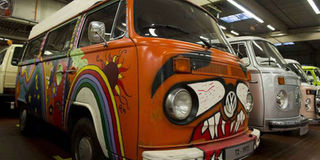I was delighted to see a Volkswagen Kombi again

A Volkswagen T2 aka kombi or bulli "Hippie Bus" from 173 is on display at a Volkswagen workshop specialised in restoring vintage T1, T2, T3 and T4 (Transporter) vans, in Hanover, western Germany, on December 9, 2013. PHOTO | AFP
What you need to know:
- I do not know the reasons behind the disappearance of the Volkswagen Kombi from our roads but I hear they used to catch fire a lot.
- The Kombi is a long vehicle, roughly the size of a Nissan or Toyota 14-seater, and so the unfolding disaster took a bit of time to come to the happy driver’s attention.
There is a type of vehicle that populated Kenya’s roads in big numbers during my youth. And then it vanished. The vanishing was not an event, it was a process.
Slowly by slowly, its numbers dwindled. And after a while, it disappeared completely. Maybe one can be found here and there, a remnant Biblical style, but it is a long time since I saw one. This is the Volkswagen Kombi.
I am shocked that there are so many of them in the streets of Rio de Janeiro. And it is not as if they are fresh from the production line. Several good-sized bags of salt could be extracted from each one of them. In fact, the one I have just seen has a registration number KPT.
In Kenyan terms, that would make it a 1971 vehicle? Unless memory fails me, the KM something series were 1969 and the KN something series 1970.
There was no KO something series; it jumped to KP. That should make 1971 the year of registration for Volkswagen Kombi KPT.
Ok, ok, ok, I get it; before you take to WhatsApp and email, I know KPT in Rio de Janeiro may have exactly nothing to do with KPT in Nairobi. I have done no research and I am writing this entirely based on the evidence before my eyes. If it transpires that KPT has nothing to do with the year, fine.
What I can tell you for a fact is that these vehicles are not new. They can pass for KPT from the Registrar of Motor Vehicles of P.O. Box something Nairobi, Kenya.
(All ye good people who comprise 70 per cent of Kenya’s population, meaning you are 40 years and below, forgive me! It is not my intention to exclude you but I had to deal with this one).
CARS EASILY CAUGHT FIRE
I do not know the reasons behind the disappearance of the Volkswagen Kombi from our roads but I hear they used to catch fire a lot. In fact, I remember being told a story of a Kombi driver who saw the many people lining the road frantically waving at him. Apparently, he had struck gold in some business deal because he did not perceive the alarm in their faces.
Instead, he happily waved back at them and kept on driving. Unbeknownst to the man, his vehicle was on fire. A Volkswagen Kombi’s engine is located at the back and that is where the fire had started.
The Kombi is a long vehicle, roughly the size of a Nissan or Toyota 14-seater, and so the unfolding disaster took a bit of time to come to the happy driver’s attention.
By the time he saw what was happening, there was just enough of it left to jump out and abandon ship. The Kombi was completely destroyed. As I have said, I have not done any research on Rio de Janeiro’s Kombis.
I am not even sure I will have the time. But each time I pass one, it is impossible not to notice it. But I thank them very much for jogging my memory.





